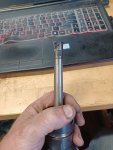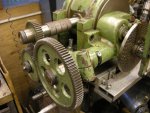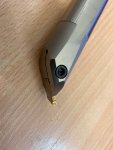machinery_e
New member
- Joined
- Feb 13, 2021
- Messages
- 23
- Reaction score
- 18
I'm working on machining figure 8 oil grooves in bronze bearings, using a manual lathe. 3.5" ID, 4" lead, 1/8" grooves. Grooves have specific start/stop points. (In other words, the grooves have to be captive in the bushing, the grooves can not lead in/out.) Lathe's slowest speed is 11 RPM. Needless to say with all that, its a very challenging job.
Running them on a CNC lathe is pretty much out, but would love to hear some of the methods used on a CNC lathe. Curious how you handle the right hand/left hand grooves? Is there a special tool that allows you to machine both at once? Or are two grooving bars used, one left hand, one right hand?
I have an idea tool wise for machining them on a CNC mill with rigid tapping which I do have access to. Programming is the tricky part-not sure its possible. With the length of the bushings (4.5") a tool to cut the 1/8" grooves, like a lollipop cutter, I think would have way too long of a length to diameter to ratio to use a conventional G2/G3 helical interpolation cycle. With my tool ideal, it would be would be perfect if the G2/G3 cycle could be combined with the rigid tapping cycle-is that even possible???
Thanks so much!
Running them on a CNC lathe is pretty much out, but would love to hear some of the methods used on a CNC lathe. Curious how you handle the right hand/left hand grooves? Is there a special tool that allows you to machine both at once? Or are two grooving bars used, one left hand, one right hand?
I have an idea tool wise for machining them on a CNC mill with rigid tapping which I do have access to. Programming is the tricky part-not sure its possible. With the length of the bushings (4.5") a tool to cut the 1/8" grooves, like a lollipop cutter, I think would have way too long of a length to diameter to ratio to use a conventional G2/G3 helical interpolation cycle. With my tool ideal, it would be would be perfect if the G2/G3 cycle could be combined with the rigid tapping cycle-is that even possible???
Thanks so much!



